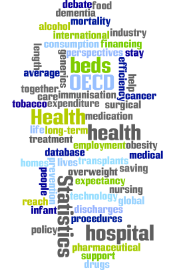OECD Health Statistics 2020 - Frequently Requested Data
OECD Health Statistics 2020
Bu haber 2020-03-29 18:19:08 eklenmiş ve 6976 kez görüntülenmiştir.

https://www.adscientificindex.com/add-profile-correction-form/?ref=banner
OECD Health Statistics 2020
OECD Health Statistics 2020
|

|
|
The online database OECD Health Statistics 2020 has been released on July 1st.
The OECD Health Database offers the most comprehensive source of comparable statistics on health and health systems across OECD countries. It is an essential tool to carry out comparative analyses and draw lessons from international comparisons of diverse health systems.
Access all datasets in the 2020 online database
Need help? Read the user's guide on how to create tables in OECD.Stat
|
| DIRECT ACCESS TO THE ONLINE DATASETS IN OECD.STAT |
| Frequently Requested Data |
| Key Results and Forthcoming Data |
|
|
- In 2019, before the onset of the coronavirus pandemic, average health spending as a share of GDP across the OECD was around 8.8%. This figure has remained largely stable since 2009 as growth in health spending remained in line with overall economic growth since the last economic crisis.
- At 17.0%, it is estimated that the United States spent the highest share of GDP on health in 2019, while Turkey allocated around 4.4% of its GDP in the same year.
Avoidable mortality
|
| Sources and Methodology |
List of indicators |

Access the full information on Definitions, Sources and Methods, as available in OECD.Stat but from one single user-friendly document
|

The full list of indicators available in the online database, in English and in French
|
How to obtain this database
OECD Health Statistics 2020 can be accessed choosing from the following options:
• The database can be accessed via OECD.Stat
• Subscribers and readers at subscribing institutions can access the database via iLibrary, our online library
• Journalists may also contact the Media Relations Division at news.contact@oecd.org
 Follow us on Twitter via @OECD_Social
Follow us on Twitter via @OECD_Social
Related Documents
| OECD Health Statistics 2019 - Frequently Requested Data |
| NOVEMBER 2019 |
| |
| |
| OECD Health Statistics 2019: website |
| Statistiques de l'OCDE sur la santé 2019 : site internet |
| |
| Access all data series in OECD.Stat via https://oe.cd/ds/health-statistics |
| |
| Access the full information on definitions, sources and methods from one single user-friendly document: |
| http://www.oecd.org/health/health-systems/Table-of-Content-Metadata-OECD-Health-Statistics-2019.pdf |
| |
| |
| Health expenditure |
| - Current expenditure on health, % of gross domestic product |
| - Current expenditure on health, per capita, US$ purchasing power parities |
| - Annual growth rate of current expenditure on health, per capita, in real terms |
| - Government and compulsory health insurance schemes, % of current expenditure on health |
| - Government and compulsory health insurance schemes, per capita expenditure, US$ purchasing power parities |
| - Annual growth rate of government and compulsory health insurance schemes, per capita expenditure, in real terms |
| - Out-of-pocket expenditure, % of current expenditure on health |
| - Out-of-pocket expenditure, per capita, US$ purchasing power parity |
| - Current expenditure on pharmaceuticals and other medical non-durables, % of current expenditure on health |
| - Current expenditure on pharmaceuticals and other medical non-durables, per capita, US$ purchasing power parities |
| |
| Health care resources |
| - Physicians, density per 1 000 population |
| - Nurses, density per 1 000 population |
| - Medical graduates, density per 100 000 population |
| - Nursing graduates, density per 100 000 population |
| - Hospital beds, density per 1 000 population |
| - Psychiatric care beds, per 1 000 population |
| - MRI units, per million population |
| - CT scanners, per million population |
| |
| Health care activities |
| - Doctor consultations per capita |
| - MRI exams, per 1 000 population |
| - CT exams, per 1 000 population |
| - Inpatient care discharges (all hospitals), per 100 000 population |
| - Average length of stay, inpatient care, days |
| - Average length of stay for acute myocardial infarction (AMI) (heart attack), days |
| - Average length of stay for a normal delivery, days |
| - Caesarean sections, per 1 000 live births |
| - Pharmaceutical consumption, antibiotics (J01-Antibacterials for systemic use), DDD per 1 000 inhabitants per day |
| |
| Health status (Mortality) |
| - Life expectancy at birth, female population |
| - Life expectancy at birth, male population |
| - Life expectancy at birth, total population |
| - Life expectancy at 65 years old, female population |
| - Life expectancy at 65 years old, male population |
| - Infant mortality rate, deaths per 1 000 live births |
| - Potential years of life lost (PYLL), all causes, female population |
| - Potential years of life lost (PYLL), all causes, male population |
| - Causes of mortality: Suicides, deaths per 100 000 population |
| |
| Risk factors |
| - Tobacco consumption, % of female population who are daily smokers |
| - Tobacco consumption, % of male population who are daily smokers |
| - Tobacco consumption, % of adult population who are daily smokers |
| - Alcohol consumption, litres per population aged 15+ |
| - Obesity, percentage of female population with a BMI>30 kg/m2, based on self-reports |
| - Obesity, percentage of male population with a BMI>30 kg/m2, based on self-reports |
| - Obesity, percentage of total adult population with a BMI>30 kg/m2, based on self-reports |
| - Obesity, percentage of female population with a BMI>30 kg/m2, based on measures of height and weight |
| - Obesity, percentage of male population with a BMI>30 kg/m2, based on measures of height and weight |
| - Obesity, percentage of total adult population with a BMI>30 kg/m2, based on measures of height and weight |
| |
| Source: OECD Health Statistics 2019 |
| Last updated: 15 November 2019 |
Yorumlar
Diğer AKADEMİ haberleri

 https://www.adscientificindex.com/add-profile-correction-form/?ref=banner
https://www.adscientificindex.com/add-profile-correction-form/?ref=banner
 Follow us on Twitter via @OECD_Social
Follow us on Twitter via @OECD_Social
















